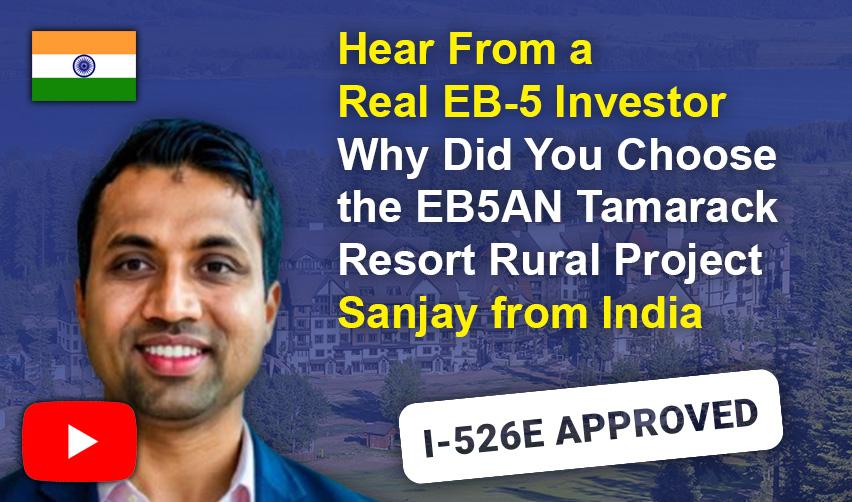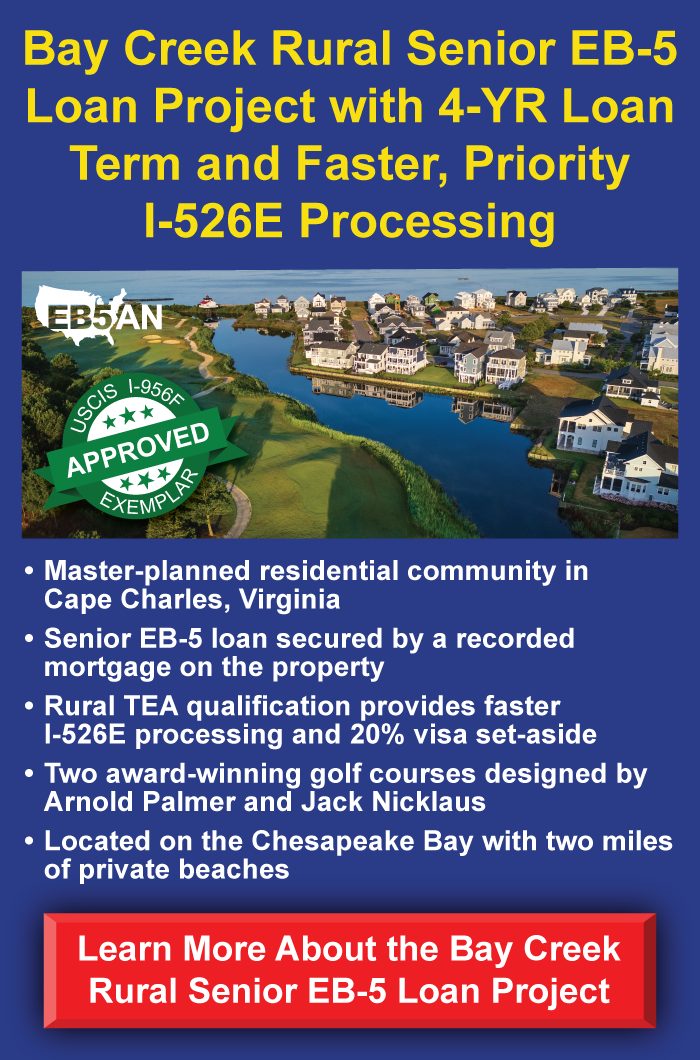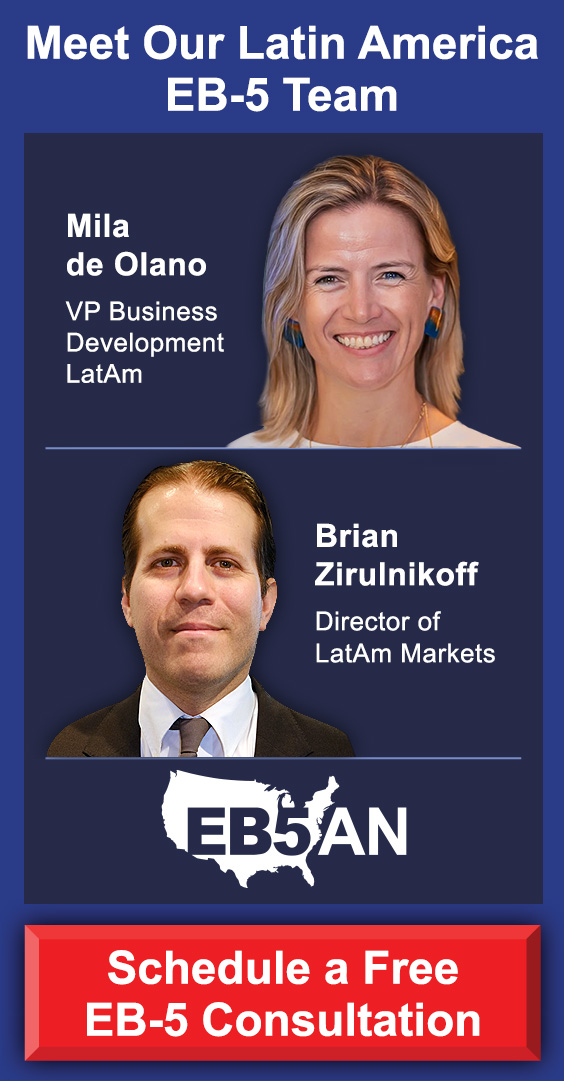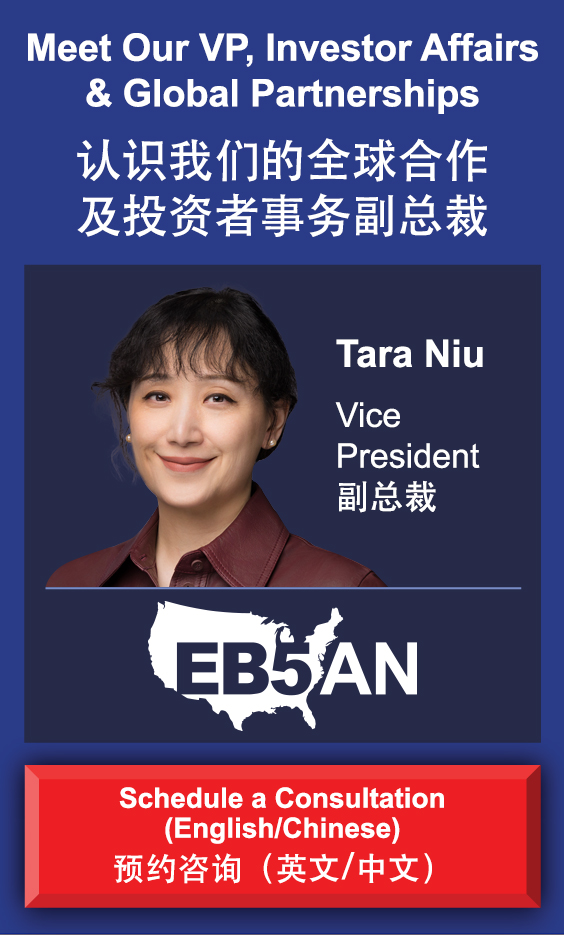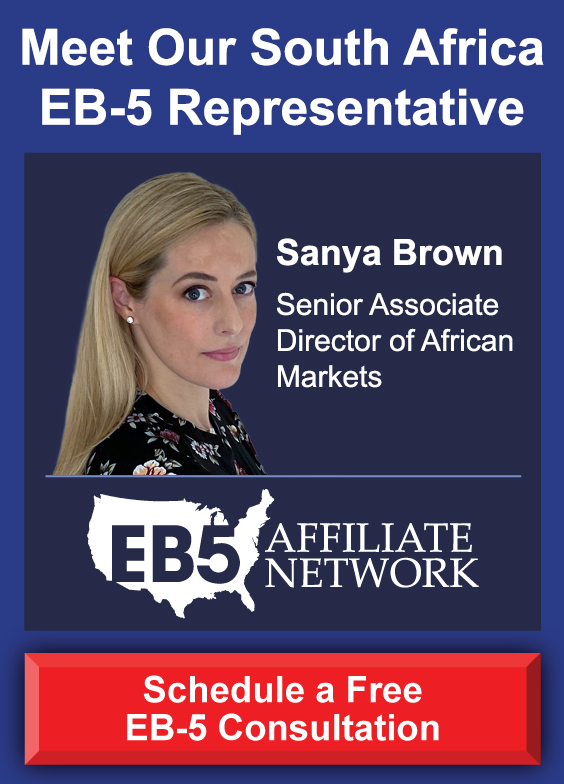I’m Sanjay Biswakarma. I’m from the northern part of India, and I came to the United States in 2018 to pursue my master’s degree. Since then, I’ve been living and working here.
I recently invested in EB5AN’s Tamarack Resort rural project (now closed for investment), and I’m very glad I did. As an EB-5 applicant, I am now in line for a U.S. Green Card and permanent residency; soon, I won’t have to worry about temporary visas expiring or losing employer sponsorship.
For anyone who wants to build his career in the U.S. long-term, there’s really nothing better than becoming a permanent resident. If that’s your goal, I’m sure you’ll find my journey with EB-5 helpful.
In this post, I want to briefly summarize my experience with EB-5 to help other investors navigate the process successfully. With careful planning, you too can invest your funds in a safe EB-5 project—for both Green Cards and timely repayment.
Watch Sanjay’s Full Interview
Watch Sanjay’s Interview Highlights
Read the Full Transcript of Sanjay’s Interview
Why I Made an EB-5 Investment
Finding a Good Immigration Attorney
My Search For a Safe EB-5 Project: Why I Chose EB5AN
My Key Advice for Other EB-5 Investors
Why I Made an EB-5 Investment
I decided to go through the EB-5 process mainly because I wanted more stability. Working on an H-1B visa always comes with uncertainty—you lose your job and the 60-day clock starts ticking, and you may have to leave the country on very short notice. That kind of risk can turn someone’s career and personal life upside down. I wanted a path that would give me peace of mind, so I decided to move forward with EB-5.
I started researching EB-5 seriously around May of last year. It took me about a year to make my decision. At first, I didn’t even know what EB-5 was until I came across EB5AN’s investor testimonials on YouTube. Hearing people talk about their real experiences gave me confidence. After that, I visited the EB5AN website and went through almost all of the investor testimonials there. That’s when I decided to reach out by email. Soon after, I was connected with Jordan from EB5AN.
From there, things started moving. Jordan explained the process, the available projects, and how everything worked. I had no idea where to begin or whom to contact, and he really helped guide me. He also introduced me to several immigration attorneys—at least ten different ones. I interviewed each of them. This was important to me because EB-5 is a long journey, easily four to five years from start to finish before you even reach citizenship. You need an attorney who’s not only qualified but experienced and responsive.
Finding a Good Immigration Attorney
There were three main things I looked for in an attorney. First, I wanted an established firm, not someone who had just started practicing a few years ago. Experience matters a lot when you’re dealing with a process as detailed as EB-5. Second, I wanted someone who had already handled many EB-5 cases from India. Each country has its own specific financial and documentation issues, and I wanted someone who had managed at least 50 Indian investor files. Third, I wanted transparency, knowledge, and fast response times. The EB-5 process involves many forms, financial verifications, and updates. You can’t afford slow communication.
After interviewing several law firms, I decided to go with Wolfsdorf. They were one of the oldest and most reputable firms I spoke to. When I talked to them, I could immediately tell they were experienced and professional. Their responses were clear, and they took time to answer my many questions. One of their team members handled my application directly, and his communication was excellent—very prompt, very organized. I must have asked him dozens of questions about timelines, forms, and my current visa status, and he had answers for all of them.
When I first filed my I-526E application in February, the USCIS changed the forms and rules around that same time. My initial submission got rejected because of those changes. But Wolfsdorf acted quickly—they identified the issue, corrected it, and refiled the application. By April, I had received the acknowledgment notice for my case. That experience confirmed to me that I had made the right choice in attorneys. Choosing the right firm really is one of the most important decisions in this process.
For my source of funds, everything came from the United States. I had earned it all here, mainly through real estate. That made my case much simpler. There wasn’t much back and forth—it was very straightforward. The whole process took around 10 days from start to finish. I submitted all the necessary financial documents, and after a few clarifications, it was finalized quickly.
If I had to give advice to other investors who are already living in the U.S. and using funds they’ve earned here, I’d say a few things. First, make sure your funds are ready to use. Many people don’t keep $800,000 or $1 million in a savings account—it’s often tied up in real estate, stocks, or other investments. You need to plan ahead for that. If your funds are not liquid, it can create delays or even affect your ability to wire the money at the right time.
When I was preparing my funds, most of mine were in stocks. Around February, the market was very unstable—stocks were dropping fast. That timing could have hurt my investment amount if I hadn’t planned ahead. So if your funds are in investments that can change value, make sure you convert them or prepare them early enough to avoid surprises.
The second piece of advice is to find an attorney who’s responsive and experienced. You’ll be working with them for years. There will be form updates, rule changes, and deadlines you don’t want to miss. An attorney who replies quickly and knows how to handle issues can make the process smooth and less stressful.
My Search For a Safe EB-5 Project: Why I Chose EB5AN
When I first started looking into the EB-5 program, I only checked a few regional centers—maybe two or three. The first time I heard about EB5AN was actually through YouTube. I saw some investor testimonial videos, and from there I began to understand that regional centers manage EB-5 projects and that investors could choose between several options. From those testimonials, I learned that real estate projects were usually considered safer, because when you invest in real property, there’s an actual asset involved. Of course, no fund is guaranteed, but at least there’s some tangible value.
I reviewed four or five different regional centers. But when I came across EB5AN, I noticed that they already had projects where construction and job creation were clearly underway. For example, Tamarack stood out because work had already begun, and the project was showing measurable progress. That gave me a sense of confidence that things were moving forward and not just at the early paperwork stage.
One major factor for me was that I’m from India. The waiting time for visa processing in urban projects can be very long, so I wanted a rural project. Rural projects have faster processing and set-aside visa categories, which really help investors from countries with long backlogs like India or China. So that became my first priority. The second was job creation. I wanted a project where the required jobs were already being created or guaranteed. When I was deciding, there were really only two options—Tamarack and one other project that was still just starting. The other developer was still laying the foundation and promised a guaranteed return of funds, but there was no job creation yet. Tamarack was rural and already had job creation verified. That’s why I chose Tamarack.
During the process, I interacted with several attorneys and different regional centers, but my experience with EB5AN’s team—especially Jordan—stood out. He knew the details of the project and the EB-5 process very well.
What impressed me most was EB5AN’s transparency. When I was applying, none of the Tamarack investors had I-526 approvals yet. I asked Jordan directly about that, and he told me the truth: no approvals yet, and I was among the first fifty investors. He didn’t try to hide it or spin it. That kind of honesty gave me confidence. I knew I was dealing with a team that wouldn’t mislead me just to make a sale.
Jordan explained both the positives and negatives clearly. The openness from the EB5AN team made a big difference. They didn’t just tell me what I wanted to hear. They shared realistic information about the process, the risks, and the project timeline. I had spoken with another regional center that was doing a similar real estate project in Seattle.
When I asked them basic questions—like whether their project was rural or urban—they didn’t even know. That lack of clarity made me uncomfortable. In comparison, EB5AN’s team gave detailed, accurate answers. Their confidence and understanding of the EB-5 program helped me feel that I was making the right choice.
I also looked carefully at the project developer. For Tamarack, the builder was MMG. It was their first time working on an EB-5 project, but they had done many other developments in Florida. I went through their track record to see how many projects they had completed successfully. Even though this was their first EB-5 experience, they had strong experience in construction overall. I studied their past projects and saw that they had delivered what they promised in Florida. That gave me some comfort.
Tamarack stood out because job creation was already confirmed, and construction was advancing. The other project was just starting with land and early infrastructure. So even though MMG was new to EB-5, the combination of a strong regional center, verified job creation, and visible progress convinced me.
I was very careful during my due diligence. I checked how far along construction was, asked for updates, and verified whatever information I could find. The difference between projects that exist only on paper and those that are already operating is huge. I wanted a project that was past the planning stage. Tamarack fit that description.
My Key Advice for Other EB-5 Investors
When I started looking into EB-5 investment options, I quickly learned that the two most important parts are the regional center and the project itself. For the regional center, I focused on history and performance. I wanted to know how many projects the regional center had completed, what their success rate was, and whether investors had received their Green Cards and repayment. A strong track record gives you confidence. You can see that they know how to manage filings, handle investors, and keep communication clear.
When it comes to the project, the first thing I check is whether it already has I-956F approval. That’s very important because it shows that the project has gone through government review and meets the requirements. The next thing—and maybe the most important—is job creation. The whole purpose of EB-5 is to create at least ten jobs per investor. Without those jobs, your Green Card process won’t move forward. If the jobs have not yet been created, I study the project’s job-creation estimates carefully. I look at how they calculated the numbers, what economic model they used, and whether their assumptions make sense.
I also look closely at the developer’s background. How many projects has the builder completed? Have they done EB-5 projects before? Did they return the money to investors on time? How many I-526 approvals came from those projects? A builder’s past tells you a lot about what to expect. I also check how active and transparent the communication is from both the developer and the regional center. They should give regular updates and be open about progress or delays.
Another thing I’ve learned is to stay updated on market changes. The EB-5 rules can change fast, and it’s important to know what’s new—especially around visa set-asides, processing times, and sustainment rules. Keeping up with those changes helps you make better choices.
There’s also one detail many investors overlook: knowing your position in the project. For example, if a project is approved for 100 EB-5 investors and 100 jobs have been created so far, those jobs will only cover the first 10 investors if each needs 10 jobs. If you come in later, like investor number 50 or 60, you could face problems if more jobs aren’t created. You need to understand exactly where you stand in that lineup and how many jobs are already available for your spot. Ideally, choose a project that already has all the jobs created or provides a job-creation guarantee. That way, even if you’re one of the later investors, your immigration outcome won’t be at risk.
On the immigration side, the law firm of Wolfsdorf was excellent. They’re experienced, professional, and very transparent. Some attorneys I spoke with earlier said they would charge extra if an RFE came in, but Wolfsdorf was clear from the start about how they handle everything. They don’t hide fees. In my case, I didn’t receive an RFE, but there was a filing issue when USCIS changed the EB-5 application form in February. My first filing used the old version, and it got rejected. Wolfsdorf fixed it immediately and refiled right away. That kind of quick response really matters.
As for EB5AN, I can say from my own experience that it’s one of the best regional centers out there. Their track record speaks for itself—many approved projects and successful investors. The team is very professional and knowledgeable. I worked closely with Sam and his team starting around May last year, and the support I received was outstanding. They were always available to explain things clearly and guide me through every step.
If a friend asked me where to start, I’d tell them to look at regional center history, project approval, job creation, builder record, and to make sure their position in the investment is clear. Then choose a strong attorney and a regional center that communicates well and has proven success. That combination made the whole process smooth for me, and I would recommend both Wolfsdorf and EB5AN to anyone considering an EB-5 investment.

